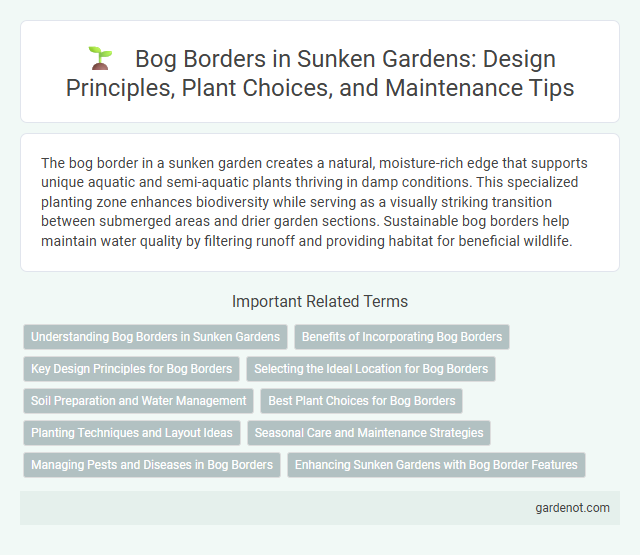The bog border in a sunken garden creates a natural, moisture-rich edge that supports unique aquatic and semi-aquatic plants thriving in damp conditions. This specialized planting zone enhances biodiversity while serving as a visually striking transition between submerged areas and drier garden sections. Sustainable bog borders help maintain water quality by filtering runoff and providing habitat for beneficial wildlife.
Understanding Bog Borders in Sunken Gardens
Bog borders in sunken gardens play a crucial role in maintaining moisture levels essential for bog plants like carnivorous species and moisture-loving perennials. These borders often consist of specialized soil mixes rich in organic matter, promoting water retention and supporting unique plant communities adapted to acidic, low-nutrient conditions. Properly designed bog borders enhance biodiversity, create natural filtration systems, and contribute to the overall microclimate stability within sunken garden environments.
Benefits of Incorporating Bog Borders
Bog borders enhance garden biodiversity by providing a unique wet habitat that supports moisture-loving plants and attracts amphibians and pollinators. Their natural filtration properties improve water quality in sunken gardens by absorbing excess nutrients and pollutants. Incorporating bog borders also aids in managing surface runoff, reducing erosion, and promoting sustainable water retention.
Key Design Principles for Bog Borders
Bog borders require careful soil moisture control, utilizing water-retentive substrates like sphagnum peat or coir to replicate natural bog conditions. Plant selection emphasizes moisture-loving, acid-tolerant species such as carnivorous plants, sedges, and moisture-dependent wildflowers that thrive in waterlogged, nutrient-poor soils. Incorporating gradual transitions between wet and drier zones enhances biodiversity and stability, promoting ecological balance while preventing water stagnation and root rot.
Selecting the Ideal Location for Bog Borders
Selecting the ideal location for bog borders involves choosing areas with consistently moist, acidic soil that can retain water without flooding. Positioning near natural water sources or low-lying garden sections ensures optimal moisture levels for bog plants. Proper sunlight exposure is crucial, with partial shade often preferred to prevent excessive evaporation and stress on sensitive species.
Soil Preparation and Water Management
Bog border soil preparation involves creating an acidic, nutrient-poor substrate by mixing peat moss, sand, and leaf mold to mimic natural bog conditions. Water management requires maintaining consistently moist soil with a high water table to support moisture-loving plants and promote healthy root development. Installing a water-retentive liner or shallow irrigation system helps regulate moisture levels and prevent drying during dry periods.
Best Plant Choices for Bog Borders
Optimal plant selections for bog borders include species that thrive in consistently wet, acidic soils such as Iris pseudacorus (Yellow Flag Iris), Lobelia cardinalis (Cardinal Flower), and Caltha palustris (Marsh Marigold). These plants provide vibrant blooms and foliage while supporting moisture retention and soil stabilization in sunken garden bog areas. Incorporating Sphagnum moss and Carex species enhances bog border biodiversity and improves water filtration efficiency.
Planting Techniques and Layout Ideas
Bog border planting techniques emphasize layering moisture-loving species such as sedges, marsh marigolds, and iris to create a naturalistic and lush appearance. Strategic layout ideas include grouping plants by height and water tolerance to mimic natural bog habitats, with taller species at the back and low-growing plants at the front for visual depth. Incorporating water-retentive substrates and gradual slopes ensures optimal drainage and moisture retention, enhancing plant health and aesthetic appeal in sunken garden bog borders.
Seasonal Care and Maintenance Strategies
Bog borders in sunken gardens require consistent moisture retention and nutrient-rich soil to thrive throughout seasonal changes. Implementing mulch layers during autumn prevents soil freezing and conserves moisture, while spring pruning encourages healthy new growth and removes dead plant material. Monitoring water levels ensures optimal hydration in summer, preventing drought stress and promoting vibrant bog plant health.
Managing Pests and Diseases in Bog Borders
Managing pests and diseases in bog borders requires selecting resistant plant species and maintaining proper water levels to prevent fungal growth. Introducing beneficial insects like ladybugs and predatory nematodes helps control aphids, slugs, and other common bog pests without harmful chemicals. Regular monitoring and removing infected plant material minimize the spread of rust, mildew, and root rot, ensuring a healthy sunken garden ecosystem.
Enhancing Sunken Gardens with Bog Border Features
Incorporating a bog border in sunken gardens enhances moisture retention and supports diverse aquatic plants such as irises and marsh marigolds, creating a vibrant, natural ecosystem. This feature aids in natural water filtration and provides habitat for beneficial insects and amphibians, promoting ecological balance. Selecting native bog species ensures low maintenance while boosting the garden's aesthetic and environmental value.
Bog border Infographic

 gardenot.com
gardenot.com